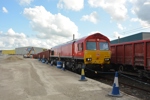Analysis by HS2 suggests that thousands of properties along the route of the high-speed line could gain access to ultrafast broadband using spare data capacity sold to broadband providers.
Phase One of the line from London to the West Midlands runs through largely rural areas of Buckinghamshire, Northamptonshire, Warwickshire and Staffordshire. Many of the areas identified are said to lag behind the rest of the UK in terms of data speed and mobile coverage.
Under the plans, HS2 would sell mobile and broadband providers access to spare capacity in the fibre-optic cabling and telecoms masts being built to support the railway’s signalling and telecoms.
Installation of direct fibre connections needed for the highest broadband speeds in rural areas can be prohibitively expensive, because of the small number of potential customers.
HS2’s analysis of data held by regulator Ofcom found that more than 500 postcodes within 5km of the line don’t have access to broadband speed above 100Mbit/s. That includes over 200 postcode areas that currently don’t even have access to ‘decent’ broadband speeds, considered to be at least 10Mbit/s.
Rail Minister Lord Hendy said: “Investment in our transport infrastructure can boost opportunities and drive economic growth in every part of our country. This scheme will have a positive impact on local areas for generations to come.”
Tim Ward, HS2 Ltd’s Head of Telecoms Engineering, said: “HS2 will provide fast, efficient and reliable rail journeys between Britain’s two largest cities while freeing up space on the existing main line for more local trains. But we’re also determined to ensure that we get the most value out of our new infrastructure and support the local community wherever possible.”
The initiative is designed to complement an existing push to improve rural broadband including the £3.8m ‘England’s Connected Heartland’ scheme, which involves a similar project to introduce 5G technology along the new East-West Rail route between Oxford and Milton Keynes.
HS2 is expected to open between 2029 and 2033, but telecoms companies could get access to masts and fibre-optic cabling two years earlier, during the testing and commissioning phase.
Around 2,000 km of fibre-optic cabling will run alongside the railway, with the telecoms masts each located in a small, dedicated compound. From a third-party perspective, this makes the network more secure than cable buried under public roads, as well as easier to access for maintenance and future upgrades.

















Login to comment
Comments
No comments have been made yet.